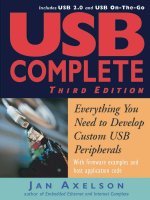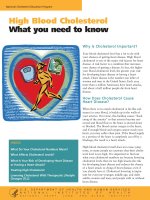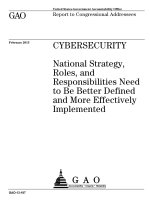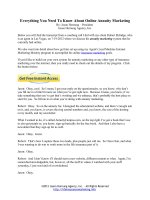Tài liệu Currency Trading Basics Everything you need to start profitable trading today pdf
Bạn đang xem bản rút gọn của tài liệu. Xem và tải ngay bản đầy đủ của tài liệu tại đây (221.88 KB, 46 trang )
Currency Trading Basics
Everything you need to start profitable trading today
Published by Dean Watt at Smashwords
Copyright 2013 Dean Watt
Smashword Edition License Notes
Thank you for downloading this free ebook. You are welcome to share
it with your friends. This book maybe repoduced, copied and
distributed for non-commercial purposes, provided the book remains in
its complete original form. If you enjoyed this book, please return to
smashword.com to discover other works by the author. Thank you for
your support.
Table of contents
Learn forex trading
What is a currency pair?
Forex pips explained - What is a pip?
Forex Lots Explained - What is a lot?
Leverage
Forex margin explained - What is forex margin?
What is the risk of ruin?
Forex Money Management is the traders friend
Want to learn how to become an auto forex trader ?
About The Author
Learn forex trading
Trading the foreign exchange market is a great way to make extra
income. However to be able to earn consistent profits takes time,
dedication and effort. The only way we can become profitable is
through learning.
When we take the time to learn we begin to understand how we can
make money from the forex market. As we learn we are developing
essential skills that will make us money for life.
Why learning and experience matters
When we are starting out on our journey to trading success. We do not
understand the trials and pitfalls that lay ahead. We believe that
making money from the markets is easy. All we need to do is follow a
technique or an indicator and watch the profits flow.
The reality is very different. Instead of making profits we lose money.
We keep losing money until we have learned enough skills to become
successful.
Only by trading and learning and learning and trading do we gain the
understanding to become profitable. How do I know? Well I have been
on this path too. I have dedicated myself for years to learning and
improving. I have gained the skill and knowledge to become
consistently profitable in the forex market.
Along the way I have learned that there is more than 1 way to make
money in forex. We are all unique and we have to find a way to trade
that works for us. Here I share my knowledge on all aspects of making
money from the foreign exchange market.
The basics – The foundations of success
One of the most important lessons I can give you is to learn your
basics. When we understand these basic building blocks we have the
knowledge that underpins all of our future forex trading and
knowledge.
The forex basics are:
• Pips
• Lots
• Leverage
• Margin
You will learn about these subjects in this e-book and this will give you
the back ground knowledge you need. By learning these basics you
have given yourself a great foundation for your future trading.
These four topics tell us:
• What profits can be expected per pip
• The basis of risk control and over-trading
• Teaches you how to maximize your profits with broker leverage
while minimizing risk
• How our brokers lend us money to trade and how this effects our
trading
Learning about advanced forex concepts
Now that we understand the building blocks we can move on to more
advanced skills and concepts. This is where we can start to learn the
how to make money and develop the skills to keep it.
The core advanced concepts are
• Money management
• Risk of ruin
Be a better trader with money management
On our road to successful trading we eventually discover the
importance of money management. Every trader must learn this skill to
be successful. However money management is normally learned the
hard way. After we have lost thousands of dollars and years of struggle
trying to be profitable
Once we understand the power of these two concepts our trading will
never be the same again. Money management turns us into a
professional trader and using money management means we have
taken a giant step towards profitability.
My 15 minute forex investing system is available to you for free on my
website. It has all the tools you need to start making money in forex. It
is a complete money management system and can be used by all
traders to help control our risk and boost our profits.
This gives us a professional way of managing our money.
Follow a professional for accelerated results
One way we can accelerate our profits and short cut our learning is by
following a professional trader. As we know knowledge and
profitability takes time to learn. It takes on average 3 years of hard
work for a trader to become consistent enough to make money.
Most people trade forex because they want to make money but most
fail in the first year. By following a professional we can start making
money because a professional has found their own way of trading, they
have learned the skills and persevered and become profitable.
To follow a professional trader their trading account is linked to our
trading account via the internet. When they trade we trade and this
gives us an automatic way of making money.
How I make my money from the forex market
We have talked about finding our own way of earning profits from the
forex market. The way I make my money is by being a money manager
and I use an investment approach. I use my professional money
management strategy and combine it with professional signal
providers.
I am looking to use a professional (or portfolio of professionals) to earn
between 20% and 100% return per year. I then use my money
management system to protect myself and control the trading signals I
receive. If a professional stops being profitable then I simply remove
them and replace them with a more profitable trader.
By making consistent returns every year I use the power of
compounding to multiply the money my trading account. This gives me
an automated way of making consistent long term profits and is a true
road to wealth.
It takes me 15 minutes a day to control my traders and make my
money. This is my 15 minute forex investing system. You can sign up to
use my system for free here.
What is a currency pair?
All currencies are traded in pairs and these pairs tell us which to
countries currencies are being traded. The pair is defined as the Base/
Quote. We read the the currency pairs as follows.
EUR/GBP (Euro / British Pound)
USD/CAD (US Dollar / Canadian Dollar)
EUR/CHF (Euro / Swiss Franc)
GBP/USD (British Pound / US Dollar)
ETC.
When we buy a currency pair we are buying the first part of the
currency pair which is called the base. We are also simultaneously
selling the other currency called the quote. When we sell a currency
we sell the base and buy the quote.
The base is always a fixed amount.
The base is always 1.
Forex pips explained - What is a pip?
A pip is the 4th decimal place when looking at a currency pairs price. A
pip is 0.0001 move in the currency. So if we are trading EUR/USD at
1.2984 and the currency moves to 1.2985 it has moved 1 pip. This is
important as profit and loss are calculated using pips.
Let’s say we have a pip worth $10 and we have a profitable trade of 10
pips. $10 X 10 pips would give a profit of $100 on the trade.
The exception to the rule
When trading the Japanese Yen (JPY). In this case the 2nd decimal
point is the pip. A Yen pip is a 0.01 move in the currency. Let’s say we
are trading USD/JPY at 78.15 and the currency moves to 78.14 it has
moved one pip.
4 or 5 digit broker?
Depending on which forex broker you choose we may have either a 4
decimal place price feed or a 5 decimal place feed.
We know that pips are the 4th decimal place on most currencies. The
5th decimal place offered by some brokers is called a pipette and is
1/10th of a pip.
Let’s say a pip is worth $10. If on a 5 digit broker the currency moves
0.00001 which is the smallest move in any currency. This move is worth
$1.
What about the Yen?
On a five digit broker the yen (JPY) has 3 decimal places and the 3rd
decimal is the pipette. Again it is 1/10th of a pip.
Forex Lots Explained - What is a lot?
A lot is often called a Standard Lot, but there is also a Mini Lot and a
Micro Lot. A Standard Lot is 100,000 units of currency. A Mini Lot is
10,000 units and a Micro Lot is 1000.
CBT means this lot size is unavailable and Cannot Be Traded.
As we can see lot size and the lot size we choose to trade can affect
how much of a currency we are trading. This in turn controls our risk
profile.
It is worth noting that 0.01 of a standard lot is the same as 0.1 of a
mini lot and 1 of a micro lot.
They are all 1,000 units of currency.
It doesn't matter which we choose for our account however be careful
when selecting lot sizes as some trading platforms ask us to select the
scale we are using.
We must select the scale which is either standard, mini or micro.
However when we us a lot size of 0.1 with different scales it produces
different results. It means 10,000 when using a standard lot, 1,000 for
mini and 100 for a micro lot.
If we are using the micro lot scale and are using 1 lot (1000 units) and
we change the scale to trade mini lots instead. If we forget to change
the lot size from 1 to 0.1 we will be trading (10,000 units) which is 10
times more risk.
This can be an easy though expensive mistake.
Choose the lot size that is right for us. I have provided free calculators
on my site that have all 3 scales available.
Leverage
Most forex brokers will offer you leverage, this can be as low as 1:1 or
as high as 1:500. There are 2 types of leverage, margin leverage and
real leverage.
Margin leverage
When you open any trade you have to give you broker a deposit from
your trading account. If you wish to open 1 standard lot you are buying
100,000 units of currency. Let’s say we want to open 1 standard lot
USD/CAD and we trade with a dollar account.
Without leverage we would have to deposit $100,000 with our broker
to open a single trade. To trade safely we would need account size in
excess of $4,000,000. Without margin leverage it is almost impossible
for private traders to trade the forex market.
The leverage offered by brokers allows private traders to open trades
that would normally be too large for their accounts. Say we open 1
standard lot of USD/CAD but this time we have a leverage of 1:100.
Now instead of needing $100,000 we only need 1% to open our trade,
which is $1,000.
Margin leverage allows private traders access the forex markets.
Real Leverage
Margin Leverage can be a double edged sword. This happens because
margin leverage allows you to open lot sizes far in excess of what your
account can manage. Therefore we have to be careful to not over
trade and blow up our accounts.
Real leverage is the amount of risk you are taking per trade.
Example 1
$10,000 account
$10 per pip per standard lot. USD/CAD
Stop loss 200 pips
We open 1 trade with 5 standard lots and we are using 1:500 leverage
on our account. This means we are buying 500,000 units of currency.
To open the trade we would need to deposit only $1,000. This would
leave $9000 dollars for our account margin. (See margin section for
more detailed explanation).
The trade goes against us and hit its stop loss of 200 pips
$10 (per pip per lot) x 5 (lots) = $50 per pip for this trade.
$50 x 200 pips = $10,000 loss.
A margin call would have happened when the losses hit $9,000.
On this trade Real leverage combined with margin leverage has wiped
the trader out.
Example 2
$10,000 account
$10 per pip per standard lot. USD/CAD
Stop loss 50 pips with a 5% maximum account loss. ($10 pip x 50 stop
loss)
We open 1 trade with 1 standard lots we are using 1:100 leverage on
our account. We buying 100,000 units of currency.
To open the trade we would need a deposit of only $1,000. This would
leave $9,000 dollars for our account margin.
Again we hit our stop loss. This time however the result is different.
$10 (per pip per lot) x 1 (lots) = $10 per pip for this trade.
$10 x 50 pips = $500 loss for trade
This time the trader has managed their real leverage risk to a
maximum of a 5% loss. Even though we have a losing trade this trader
has survived and is able to make another trades.
How to control your real leverage.
This is what this book and companion website is about. Controlling
your risk while keeping you trading. Take a look at money
management, risk of ruin and forex margin explained to see how you
can reduce your real leverage whilst making the most of margin
leverage.
By controlling our trading risk we are allowing our trading systems the
time to make money.
Forex margin explained - What is forex margin?
When we trade currencies we are effectively trading very small
amounts of a currency. So small that if we were to trade a single unit
of currency we would find it extremely difficult to make any money.
We need to trade large volumes of a currency to make any meaningful
gains.
For instance a 1 standard lot is 100,000 units of currency. To trade this
we would have to buy 100,000 of the base currency. e.g. $100,000 if
trading 1 standard lot of USD/CAD. As most private traders could not
afford to buy $100,000 worth of currency our forex broker offers us a
margin trade.
Let’s say we wish to open 1 standard lot of USD/CAD. Your broker
offers us 1:100 leverage. Instead of needing $100,000 dollars to open
the trade we only need 1% which is $1,000. This makes it possible for
private traders to trade in the forex market.
Our broker is lending us the rest of the money required to open the
trade. However to do this our broker requires an initial deposit. No
deposit no trade. Our broker will also look to protect themselves from
any loss by monitoring our trading account. If our trading account
reaches zero they can close all of our open trades therefore protecting
themselves from loss. This is called a margin call.
When a trade opens we will have the initial margin deducted from our
trading account.
Margin is a representation of our account size and margin is essentially
how much money we have in our account. Margin divides our account
into 2 parts, the 1st is the initial margin or deposit required to open a
trade. The 2nd is the remaining account balance called account
margin. If both of these combined falls below our trading account
balance we have a margin call.
We have to protect ourselves from the margin call.
What is the initial margin?
Initial margin is the amount of currency (deposit) that our broker
requires from us to open our trade.
The amount of money requested from our broker depends on the
amount of leverage we have. If we trade 1 standard lot of 100,000
units of currency. The initial margin is a percentage of this amount.
Leverage size to initial margin
NOTE the initial margin is in the base currency. If we open USD/CAD it
would in USD. If you opened EUR/GBP it would be EUR etc.
We have a free margin calculator with this e-book. The calculator
stops over trading and margin calls. To start we enter our leverage into
the calculator.
Remember the currency comes as a pair. The first currency is the base
and the second the quote.
Example
We have a 10,000 dollar account.
Leverage of 1:100
We open a USD/CAD trade with 1 standard lot. We buy 100,000 units of
the base in this case USD.
To work out how much our initial margin is we look at our leverage.
We can see from the table that we need to give the broker $1,000
deposit for each USD/CAD trade opened at 1 standard lot.
As we open our USD/CAD trade $1,000 dollars is deducted from our
account and held by the broker. Until the trade is closed we have
$9,000 in our account. Once the trade is closed the $1,000 will be
returned.
If 2 USD/CAD trades were opened $2,000 would be deducted from our
account. We would have $8,000 left in our trading account. Once again
the money is returned once the trades are closed.
What if your account currency is different to the base currency?
If our account currency is different from the base currency. We would
have to convert the base initial margin into our account currency.
Example
We have a 10,000 dollar account.
Leverage of 1:100
We wish to open (buy) a EUR/CHF trade with 1 standard lot. We know
with a leverage of 1:100 we would need 1,000 Euro's (Base) to open the
trade.
We now convert this to our account currency in this case USD. First we
find out what the EUR/USD exchange rate is. (Current exchange rates
can be found on the side bar of the companion website.)
It is 1.29315 (at time of writing)
We enter the exchange rate (1.29315) into the margin calculator. The
calculator will tell us how much initial margin is required for 1
standard lot.
You would need £1,293.15 of initial margin (deposit) to buy 1 standard
lot of EUR/CHF.
Why do we need to know about margin?
Opening trades requires a deposit which reduces our trading capital.
This in turn increases our trading risk therefore we need to control it.
The risk we are avoiding is the premature closure of our trades before
they hit the stop losses. This will cause catastrophic loss to our trading
capital.
As we have to give our broker an initial margin (deposit) to open a
trade. Let examine what happens during the trade.
When we are trading our trading capital has been reduced because of
the initial margin having been removed. This gives us less money to
withstand losses. Therefore we have to be careful when we are in
draw-down to avoid a margin call.
Remember winning or losing trades still costs the same initial margin.
To reduce these costs we would either have to reduce our lot sizes,
increase our leverage or increase our account size or a combination of
the 3.
The Dreaded Margin Call
This is when our broker can close our open positions or ask us for more
money. This happens when we have open losing trades and these losses
are greater than our remaining account margin.
Example
Let’s say we have 5 open trades on USD/CAD with 1 standard lot
We have a 10,000 dollar account.
Leverage of 1:100
Value of each pip: $10 per pip with 1 standard lot
We know that 5 open trades require an initial margin of $5,000. This
leaves $5,000 account margin to whether any losses.
Each of the 5 trades goes against us. We didn't know about managing
risk so we had no stop losses. We are losing $10 per pip for each
standard lot traded. As we have 5 open trades of 1 lot, we are losing
$50 per pip.
It only takes a loss of 100 pips (100 x $50 =$5,000) and our account
margin is wiped out. The broker will give us a margin call. Note: A 100
pip move is an average move for most trading days.
What happens next?
Either we have to add MONEY to our account to keep the trades open.
OR
Our broker closes our trades and we will LOSE our account margin.
Either way we are in trouble as we have to choose either to spend
more money with no guarantee of success, or lose our account margin.
So what can we do to reduce our risk?
To do this we need to make sure that our trades are not cut short by
the margin call.
How to protect ourselves from a margin call
As with money management and risk of ruin we have to work out and
then minimize the risk. The first part is knowing how much our initial
margin will be. Then we need to know what the maximum amount of
open trades we are trading.
As each time a trade is opened an initial margin is removed from our
account. We need to work out how much this will be. I have included a
FREE calculator on my companion website to help with the
calculations.
First work out the initial margin for each currency pair we are trading.
To do this we will need to know our leverage and the exchange rates
for the base currencies to our trading account currency.
Example
Account currency USD
Leverage 1:100
EUR/GBP
GBP/AUD
Etc
In the example we would need to know the exchange rate for EUR/USD
and GBP/USD.
Enter our leverage and the exchange rates into the margin calculator.
The calculator will tell us how much initial margin we would require to
open 1 standard lot.
Next we need to know how much initial margin we are using for our
chosen lot size. We will know our lot sizes from the money
management calculator. Enter the lot sizes from the money
management calculator into the margin calculator.
Next we enter the maximum number of open trades for our chosen
system, and the percentage each that currency pair is traded. (I have
produced a series of FREE video tutorials to help you through this
process).
Once we have entered the lot size, maximum open trades and the
percentage each currency pair is traded. The calculator will tell us
how much initial margin we will need to open the maximum number of
trades.
The final part of the process is to incorporate the draw-down process.
We do this by entering into the margin calculator the size of our
trading account and what percentage risk we are taking per trade.
Once this has been entered into the calculator you will have 2
numbers. The first is our total margin risk. This is how much money we
would lose if the system opened its maximum number of trades and all
trades hit their stop losses.
The second number is your account balance. What we are looking for is
the margin risk to be lower than our account balance. If the margin
risk is greater than the account balance we have a risk of a margin call
before we hit our stop losses.
If the margin risk is greater then we can do a few things to lower the
risk. We can increase our leverage from our broker. This will reduce
the initial margin requirement. We can also reduce the percentage risk
per trade as this will lower the draw-down risk or reduce the number
of trades taken. Finally we can add funds to our trading account or a
combination of all 4.
If we have maximum leverage and a low % per trade and the margin
risk is still higher than our account balance. Think about reducing the
number of trades taken from our chosen system. For how to do this see
the FREE video tutorials.
What is the risk of ruin?
Risk is an ever present part of trading. It is something we have to live
with but it is also one area of trading that we are able to control. We
cannot know if a trade will be successful or not when we open our
trade but we can control our risk to the trade.
It is conventional wisdom to think “the higher the risk, the higher the
reward” and in some areas of finance this may be true. In areas such
as bank lending and insurance. However in trading the higher the risk
the more chance you have of blowing your trading account (losing all
your money).
To be successful in trading you need a trading system that has a
positive return (expectancy) and the time needed to make multiple
trades. If either the positive expectancy system or the time are missing
then we will not make any money.
This is why knowing and controlling our risk is the most important part
of trading. Controlling our risk gives us the time we need to increase
our account. When combined with correct money management our
profits will soar.
Let’s take a look at risk and how to calculate it.
Take for example 2 traders both trading the same system with the
same lot size and leverage. One (trader A) has a $10000 account and
the other (trader B) a $1000 account. The system incurs a loss of $500.
Trader A has lost 5% of his account but Trader B has lost a massive 50%.
Trader A has to grow their account by 5.27% to recoup the loss.
However trader B's account has to grow by 100% just to break even.
To reduce their risk trader B could either increase the size of the
trading account, reduce the lot size traded, reduce the real leverage
used or a combination of all 3. However the question still remains how
do we know when we have reduced our risk to a safe level and what is
the safe level?
The safe level is a personal thing. For 1 trader it could be 100% of their
account and for another it could be a draw-down of 30%. You will know
what is right for you. Whatever the amount that you have chosen, this
is the amount that you use when working out your risk of ruin.
Example
£10000 trading account and the trader is willing to risk 33% then £3333
is used to work out our risk of ruin.
£10000 trading account and the trader is willing to risk 50% then £5000
is used to work out our risk of ruin.
Risk of Ruin Calculator
Above is a link to the website which has the risk of ruin calculator. All
you need is to enter the Win, Loss percentage of our trading system
and the percentage risked per trade and the calculator will do the
rest.
% win of system
% Loss of system
% of account risked per trade
In the above examples let’s say the system being used has a statistical
60% win to 40% loss and $500 is being risked on each trade.
This formula uses an average win to loss ratio of 1 or parity. Check
systems pages for average win loss ratio for each system.
Risk of Ruin Calculator
Trader A
$10000 in account
$500 risked on each trade
5% risked per trade
Risk of ruin 0.03%
Trader A has a risk of ruin of 0%
(Note: this is a statistical concept and there is always some risk in
trading)
Trader B
$1000 in account
$500 risked on each trade
50% risked per trade
Risk of ruin 44.44% (per trade)
Trader B has a risk of ruin of 44%
The acceptable level of risk for your trading account is 0%. Anything
other than 0% will result in a blown account and a serious loss of
money. You may be thinking that this will not happen to me.
Remember unless you have a risk of ruin of 0% it is just a matter of
time.
How to find the win loss % and how to work out number of units of
money?
The website shows you where to find the information you need to be
able to use all of the 3 calculators provided.
On the risk of ruin calculator you will be asked to input our trading
account size. You will also be asked for the percentage we are willing
to risk on each trade. Enter these figures into the calculator along with
the win loss % and the calculator will do the rest.
Now that we understand the risk of ruin and how we can use it to
protect our account. Read the money management section to learn
how to increase our profits.
Forex Money Management is the traders friend.
Correct money management is a fantastic tool in trading. In essence it
reduces risk when we are losing money and magnifies profits when we
are winning. There are 2 types of money management.
Martingale
Anti martingale
The perils of a martingale system
Martingale is a concept from gambling theory. It is when we double our
position after each losing trade. Bet $100 and lose, the next bet would
have to be $200, then $400, then $800 etc.
In theory we could keep doubling up after a loss until we break even.
In real world trading there is a very high chance that we will run out of
money before we can break even. So instead of keeping us trading.
Martingale has had the opposite effect, it quickens our demise.
Example
$10,000 trading account with $500 risked per trade.
Loss 1, next trade $1,000 (account size $9,500)
loss 2, next trade $2,000 (account size $9,000)
Loss 3, next trade $4,000 (account size $7,000)
Loss 4, Next trade £8,000 (account size $3,000) can’t trade not enough
capital.
As we can see we cannot continue trading as our account will not
support the next martingale trade. We have reduced our account by
70% in only 3 losing trades.
So instead of reducing risk a martingale money management system
increases it and can lead to a total account loss.
Anti martingale is the correct money management strategy. It uses a
system called geometric profits. This allows us to increase your lot
sizes when we are winning and reduce our lot sizes when losing. This is
essential to manage our risk.
Correct Money Management
The system we will be using is called fixed percentage money
management. It is not the only money management system however I
find that it works well with forex trading. Fixed percentage has the
ability to generate large profits and lower risk. This makes fixed
percentage a good all round money management system.
What is a fixed percentage money management system? Simply it is a
fixed percentage of our trading account that is risked per trade. This
can be any percentage the trader wishes. It all depends on how much
risk per trade we are willing to accept.
The percentage risked per trade gives us a maximum number of trades
we can make out of our trading account. If we wish to risk 5% of our
account per trade we would have 20 trades. (100 x 5% = 20). If we
wanted to risk 2% per trade then we would have 50 trades. (100% x 2%
= 50).
This gives us great control of our risk per trade and when combined
with the risk of ruin we can easily monitor our overall risk and reward.
Use my money management Calculators
On the calculator just enter our account balance and the percentage
you wish risk per trade. The calculator will tell us how much money we
are risking per trade and this helps us calculate our lot size.
How to work out our fixed percentage money management.
First we need to decide what percentage we wish to risk. Most traders
would have a minimum of 20 trades or 5%. Once this has been decided
we can work out how much this is in trading capital.
Note: the money management calculator works this out for us. All we
need to know is how much trading capital we have and what % risk we
are willing to take. Enter this into the boxes provided and the
calculator will know tell us how much trading capital we are risking per
trade.
Example
Account size $10,000
$10,000 x 5% = $500
$500 is the maximum amount of money to be risked on a single trade.
This is 5% of our account and will give us 20 trades.
Example 2
Account size $10,000
$10,000 x 2% = $200
$200 is the maximum amount of money to be risked on a single trade.
This is 2% of our account and will give us 50 trades.
This gives a trader great flexibility to control the risk we wish to take.
This also helps us with our psychology. If we are risking 5% per trade
and we have a string of losses. We maybe finding it difficult to live
with these losses. If it feels too difficult then we are probably trading
too large a percentage per trade than we can tolerate.
If we have reduced the percentage per trade and we find this
comfortable. Then we have found a percentage per trade that is right
for us.
Geometric profits
As our account grows the amount of money risked per trade increases.
This in turn increases the lot size we can safely trade and the increase
in lot size increases the our profit. This is a cycle, the bigger our
account gets the larger the lot size we can use and the more we profit.
This is geometric profits in action.
When our trading account is growing we are using larger and larger lot
sizes however our risk per trade is always the same.
Example
Let’s say we have made $2000 profit on our initial $10,000 account.
We need to work out work out our new dollar risk per trade.
$12,000 x 5% = $600 per trade
Now $600 is our maximum dollar risk per trade and our lot sizes can be
increased. However our percentage risk is still 5% per trade. This
means we are increasing our lot size but not our risk.
Let’s look at how a loss will reduce our trading risk.
Example
Let’s say we have lost $1,000 from our $12,000 trading account leaving
us $11,000 to trade with.
$11,000 x 5% = $550
$550 is now our maximum dollar risk per trade. By following the fixed
percentage money management we would now have a lot size which
represents 5% risk per trade.
How to work out the correct lot size
The following can be a little complicated so if you do not know what
pips or a lots are. Please read our pip, lot, leverage and margin pages
for more information.
We have a calculator to help you with the calculations.
Money Management Calculator
All currencies are traded in pairs
Base/Quote
EUR/GBP Euro / British Pound
USD/CAD US Dollar / Canadian Dollar
EUR/CHF Euro / Swiss Franc
GBP/USD British Pound / US Dollar
ETC.
When we buy a currency pair we are buying the first part of the
currency pair which is called the base. We are also simultaneously
selling the other currency called the quote. When we sell a currency
we sell the base and buy the quote.
The base is always a fixed amount.
The base is always 1.
Example
$10,000 trading account
5% risked per trade.
Account Currency: Dollar









